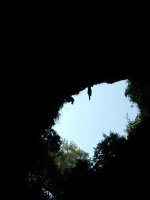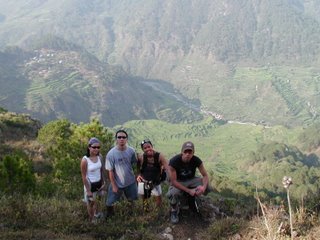Into the Abyss
Nothing could've prepared us for spelunking on our second day in Sagada. Everyone was good to go, albeit with little idea of what was awaiting us, but I'm quite sure everybody reached a natural high when we came out of Sumaguing Cave.
I hated myself for forgetting to bring my Petzl headlamp, which I left in the room at Olahbinan. The spelunking activity was the reason why I brought it to Sagada in the first place. So with no other advantage left over my cousins (except my outdoor field experience), everyone was on equal footing, relying only on the illumination of Petro-max lanterns which our two local guides brought for us.


Sagada owes its spectacular cave formations to karst topography. These landscapes abound in the Philippines and are characterized by limestone formations and sharp, chiseled rocks and outcrops. Other places in the country where karst landscapes can be found include the provinces of Cebu (which is why dolomite mining flourishes there), Bohol (the reason why the renowned tourist destination, the Chocolate Hills, were formed), and Samar Island (where the most intricate cave network, the Langun-Gobingob caves, and the largest single cavern in the country is found). I think what sets Sagada apart from these other localities is its peculiar cool climate--distinctly felt only in the Cordillera region in Northern Luzon--and the pine forests that thrive there.
Sumaguing Cave, deriving its name from the Tagalog word "saging" meaning banana because of the banana-like formations in the cave, must have been between 100-150 meters down, probably unnoticeable while you're spiraling down. I could tell that some of the stalactites and stalagmites were already dead resulting from intensive tourism activity, but there were some that were still alive and forming possibly because it was out beyond the main trail. We could hear the cacophony of bats that were hanging on the cavern ceiling and smell their unmistakable droppings (or guano) that were covering the stones and trails. EJ and JoAnn, I thought, seemed to panic at the thought of making the slightest contact with the guano, but probably resigned upon the realization later on that it was going to be futile for them to avoid it, plus the comforting expectation that it was nothing that a warm bath and intense scrubbing couldn't remove. Although I must admit I tried hard not to laugh when I heard EJ letting out several "Eeeps!"
At some point, one of our local guides asked me if I smoked "tsongki" or the Sagada "gold." I answered politely with "Hindi (no)," although it sounded more emphatic than I wanted it to. He then gave me a look and a sly smile that said he was unconvinced, probably weighing the truth in my words. I wonder whatever gave him that impression or if he was waiting for me to ask him if it was possible to get hold of some. I then reassured him finally with a negative reply by shaking my head. Maybe, if I were a different Don, I would have. But I never did ask.


Further down the cave, the local guides gave us a great time. At some points, we had to descend the rocks by stepping on their thigh or grabbing hold of their hand and lean our backs while we stepped down carefully. At one instance, we took turns using a rope to ascend one part of the cave. And then there was this part where we had to crawl through a small opening to get to the other side of the rock. When we reached the bottom of the cave, there was a small pool that was 5-10 feet deep, which Rom and I took as an opportunity to swim even though we knew the water was friggin' cold. The photo shows me jumping off from a rock ledge to get to the pool. According to the local guides, there were still other portions of the cave that remained unexplored probably for reasons of preserving the caverns or maybe because nobody has dared to explore it further. Of course, we took as many pictures as we could--Rom, Katrina, JoAnn, and Tina were all detailed for photo documentation--although some pictures still turned out blurred due to low light in the caves.
I was telling them that my experience in Palawan's St. Paul Subterranean River and even Samar Island's Langun-Gobingob caves were nothing in comparison to Sagada's Sumaguing Cave, mainly because of the empirical and hands-on feel of going through each portion of the cave--an experience that Palawan's caves deprived anyone who entered it. As for Samar's caves, while it was equivalently majestic in its own way, spelunking through was just too difficult for me. I think what made the whole caving experience in Sagada undeniably mad fun was because the group--composed of my brother and closest cousins--made it that way. Sumaguing cave was unforgettable and the time with my cousins equally irreplaceable.
The Road to Kiltepan
Before anything else, I should say now that I have gone down in my family's history (at least for my cousins) as the one who got them lost on the road to Kiltepan--all because of a sign I was anticipating that we'd see that would point us to the direction where it was, but the sign was nowhere to be found. Remember that we opted to follow and use a map that we bought from the souvenir shops instead of hiring local guides? Yeah we still did that when we went to Kiltepan that afternoon, on the same day we went to Sumaguing Cave.
Trekking to Kiltepan promised a magnificent view of rice terraces of Bontoc in the Mountain Province. Probably, I should let the photos we took speak for themselves.


We planned on taking a brief dip at Bokong Waterfalls, about 25 mins away from the town proper, after visiting Kiltepan. Unfortunately, dusk was on our heels and we did not make it there--the consequence of taking wrong turns out of the trial-and-error method of finding our own way.
The experience that afternoon made us realize that although the treks we had took more time, it was an adventure all in itself. The idea was to follow a map and eventually get to the place which you set out for--much like in a treasure map where X marked the spot where the hidden treasure was. The trek was all worth it. Too bad Katrina wasn't able to join us in going to Kiltepan, too tired after spelunking earlier during the day.